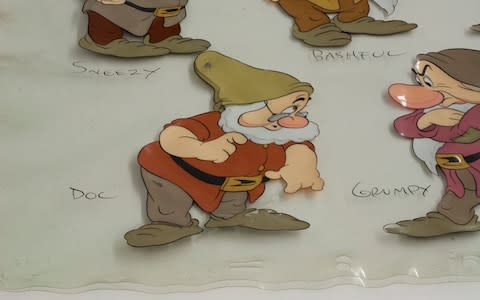How a British scientist saved Disney's oldest cartoons from destruction

Disney has called in a British art conservation expert to save priceless original film cells from some of their most beloved animations from being lost to the ravages of time.
Films such as Snow White and The Seven Dwarfs, Pinocchio and Alice in Wonderland were hand-painted, frame by frame, on plastic sheets.
Some of these cells are more than 80 years old and have started to warp, causing the paint to flake.
But British scientists have come up with an unexpectedly simple solution. While most precious artworks benefit from a dry environment, they found that increasing humidity caused paint to reattach itself, thus reversing the damage.
Dr Tom Learner, from the Getty Conservation Institute, and formerly a conservationist at Tate Modern, has been working with Disney Animation Research Library in Los Angeles.
“It’s always nice to end up on a happier note rather than the doom and gloom of degradation,” he told a meeting of scientists in Austin, Texas.

“As part of our Disney cell study one of the problems was with the plastic deforming through degradation. It’s very sensitive to humidity, so when the humidity drops to a dry condition the paint becomes rippled.
“We found just by putting these things in chambers and ramping up the humidity you actually are able to re-adhere the paint to the plastic, so while we are not able to flatten the cells, we can re-adhere it. What’s lovely about this is we haven’t had to put in any glue, adhesive or anything to stick the paint down. This means the paint is safe, will not crack and it can be digitally photographed. We are thrilled.” But other ageing plastic artworks are in danger of degrading, he warned.
Some have already been badly damaged, such as Naum Gabo’s 1927 sculpture Model for Construction in Space ‘Two Cones’ in the Tate collection.
Dr Learner said: “The scary thing about these sorts of plastics is they appear very stable for a long time and then just suddenly go.”

Other works, such as Eva Hesse’s Expand Expansion, comprising polyester poles draped with sheets of latex, and Antoine Pevsner’s Portrait of Marcel Duchamp, have shrunk or become warped and discoloured.
Dr Learner added that artists such as Damian Hirst often work with various biological materials which cannot last as long as marble or bronze. “It’s just part of the deal,” he said. “Plastic was mouldable so (artists) could do extraordinary things with it but the degradation wasn’t predicted and when it happened it was terrible.
“But had they known about the degradation they maybe would not have made their pieces and then we wouldn’t have them.”
Dr Lynn Brostoff, of the Library of Congress in Washington, said many valuable documents, such as Thomas Jefferson’s handwritten draft of the Declaration of Independence, were at risk because they had been laminated. “Well you know, now we think it wasn’t such a great idea,” he said. The declaration is kept in an oxygen-free chamber to halt any further degradation.

 Yahoo News
Yahoo News 
